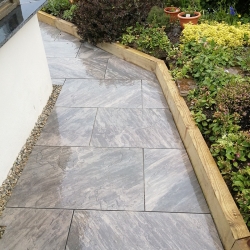0333 321 5091
01909 768 760
Mon - Fri 7:00 AM - 5:00 PM
Sat 8:00 AM - 2:00 PM

We Deliver
Nationwide
0333 321 5091
01909 768 760
Mon - Fri 7:00 AM - 5:00 PM
Sat 8:00 AM - 2:00 PM

We Deliver
Nationwide

Over the years, DIY enthusiasts, home owners and landscapers have started to realise that Porcelain Paving is a smart and cost-effective choice. This is due to the strong durability, wider appearance choice compared to natural stone and a high resistance against the elements. A new question regarding this porcelain option started to become increasingly common, ‘How do you cut Porcelain Paving Slabs?’. Cutting this slab option does require a little more leg work to ensure the cuts are clean and there is minimal wastage so based on this question, we have put together a small guide, hoping it puts our readers on the right path.
Disclaimer: The information provided in this guide is for informational purposes only. Paving Stones Direct UK Ltd is not responsible for any damages, injuries, or losses resulting from the use of this information. All actions taken based on the information in this guide are solely the responsibility of the user. It is recommended to seek professional advice tailored to your specific circumstances before undertaking any project.
Selecting the right tools means being able to effectively cut porcelain into the desired shapes. Here’s an overview of the tools you will need, each suited for different types of cuts:
Depending on the project scope, you may find that one tool is not enough and multiple are needed so it’s best to get a bit of advice before making any firm decisions.
Proper preparation could be the difference between success and failure so it’s always worth putting in the work at this point to ensure any cuts are done to a high standard. Follow these steps:
Now the preparations have been completed, now it’s time for the executions. Below is an overview of how to cut a slab based on the types of cuts required:
Additional Advice:
It’s important to smooth out any rough edges using a diamond hand pad or rubbing stone. This step is not only good aesthetically, but also for safety as any cuts made can be sharp, even after laying so take extra time in ensuring that safety measures have been taken. This will also make the slabs much easier for laying in the bedding.
To ensure we have covered as much as possible, here is a bonus FAQ for some of the more popular questions.
While daunting at first, porcelain cuts can really make your new garden patio stand out and help to shape the paving to your home.
We firmly believe in giving our customers the best experience possible, so that is why we strive to provide the best quality porcelain paving at the lowest prices, all while providing support and advice. If you require any information regarding porcelain paving stones or anything else, please give us a call on 0333 321 5091 or email us on sales@pavingstones.co.uk.